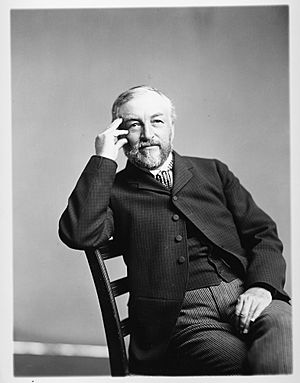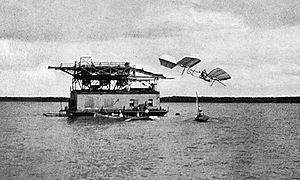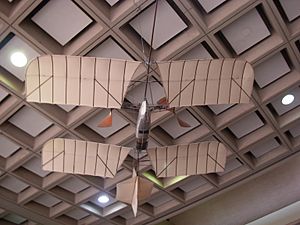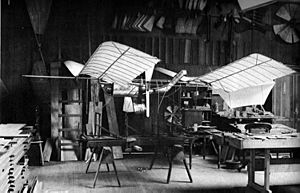Samuel Langley facts for kids
Quick facts for kids
Samuel Langley
|
|
|---|---|

Langley, circa 1895
|
|
| 3rd Secretary of the Smithsonian Institution | |
| In office 1887–1906 |
|
| Preceded by | Spencer Fullerton Baird |
| Succeeded by | Charles Doolittle Walcott |
| Personal details | |
| Born | August 22, 1834 Roxbury, Massachusetts |
| Died | February 27, 1906 (aged 71) Aiken, South Carolina |
| Nationality | American |
| Known for | Solar physics |
| Awards | Rumford Medal (1886) Henry Draper Medal (1886) Janssen Medal (1893) |
| Signature | |
Samuel Pierpont Langley (born August 22, 1834 – died February 27, 1906) was an American scientist. He was a pioneer in aviation, an astronomer, and a physicist. He is famous for inventing the bolometer, a tool that measures heat.
Langley served as the third leader, called Secretary, of the Smithsonian Institution. He was also a professor of astronomy at the University of Pittsburgh. There, he led the Allegheny Observatory.
Contents
Life and Career
Samuel Langley was born in Roxbury, Boston, on August 23, 1834. He went to Boston Latin School and then the English High School of Boston. After school, he worked at the Harvard College Observatory.
Later, he moved to the United States Naval Academy. He was a math professor there, but his main job was to fix up the Academy's small observatory. In 1867, he became the first director of the Allegheny Observatory. He also became an astronomy professor at the University of Pittsburgh. He kept this job even after becoming the Secretary of the Smithsonian Institution in 1887. Langley also started the Smithsonian Astrophysical Observatory.
Work at Allegheny Observatory
When Langley arrived in Pittsburgh in 1867, the Allegheny Observatory was in bad shape. Its equipment was broken, and the building needed repairs. With help from a friend, William Thaw Sr., Langley improved the observatory. He added new tools, like a special telescope to track stars.
Langley found a clever way to get money for the observatory. He sold accurate time to cities and railroads. Before this, clocks were often wrong, and exact time wasn't very important. But with railroads, precise time became vital. Trains ran on schedules, and if clocks differed, trains could crash.
Langley used his telescope to create a very accurate time system. It was called the Allegheny Time System. He sent time signals twice a day through telegraph lines. These signals reached railroads across the US and Canada. The money from selling this time helped fund the observatory.
Once the observatory had enough money, Langley focused on studying the sun. He was a skilled artist and drew many detailed pictures of solar events. His 1873 drawing of a sunspot became very famous.
In 1886, he won the Henry Draper Medal for his work on the sun. His studies of infrared light and his invention, the bolometer, were very important. They helped scientist Svante Arrhenius make the first calculations about the greenhouse effect.
Aviation Work
Langley tried to build a working airplane that could carry a person. His smaller models flew well, but his two attempts at piloted flight were not successful. He started experimenting with models in 1887. He even built a rotating arm, like a wind tunnel, to test his designs.
He learned that a plane needs thrust to overcome air resistance. He also found that wider, flatter wings had more lift and less drag. In 1902, he realized that a plane of a certain size and weight would need less power to fly faster.
His first big success was on May 6, 1896. His unpiloted model, called Number 5, weighed about 25 pounds (11 kg). It flew 2,300 ft (700 m) and then 3,300 ft (1,000 m) after being launched from a boat. This was ten times farther than any previous flying machine. It showed that such a craft could be stable and get enough lift.
Later that year, his Number 6 model flew over 5,000 feet (1,500 m). Because his models were so successful, the War Department gave him $50,000 in 1898. The Smithsonian also gave him $20,000 to build a piloted airplane. He called it an "Aerodrome". Langley hired Charles M. Manly as his engineer and test pilot.
The engine for the Aerodrome was very powerful, much stronger than the one used by the Wright brothers. This engine was a major achievement for the project. The piloted Aerodrome had two sets of wings, one behind the other. It had a tail for steering up, down, and side to side.

Langley wanted to test his plane safely over the Potomac River. This meant he needed a catapult to launch it. The plane had no landing gear. The idea was for it to land in the water after flying. Langley stopped the project after two crashes during launch in October and December 1903.
In the first crash, a wing hit part of the catapult, and the plane fell into the river. In the second crash, the plane broke apart as it left the catapult. Manly, the pilot, was rescued unharmed both times. Newspapers made fun of the failures, and some politicians criticized the project.
Years later, in 1914, the Aerodrome was changed and flown a short distance by Glenn Curtiss. This was part of an effort by the Smithsonian to improve Langley's reputation in aviation. However, courts still ruled in favor of the Wright brothers' patent.
Unlike the Wright brothers, Langley did not have a good way to control a large airplane. If the Aerodrome had flown stably, Manly would have been in danger when it came down for an uncontrolled landing.
Bolometer Invention
In 1880, Langley invented the bolometer. This tool was first used to measure far infrared radiation, which is a type of heat. The bolometer is so sensitive that it can detect a temperature change of less than 1/100,000 of a degree Celsius. This invention helped scientists measure the amount of solar energy reaching Earth.
He published a paper about it in 1881. He also used it to try and measure the Moon's surface temperature. His measurements of how carbon dioxide in Earth's atmosphere blocked infrared radiation were used by Svante Arrhenius. This helped Arrhenius calculate how the climate might change if carbon dioxide levels doubled.
Standard Time Service
Langley played a big part in developing time services in America. Starting in the late 1860s, he helped create systems that used astronomy to provide accurate time. His work with railroads was key to setting up Standard Time Zones. He sold precise time signals to the Pennsylvania Railroad, which helped fund his observatory.
Death
Langley felt responsible for money problems at the Smithsonian Institution in 1905. An accountant was found to be taking money. Langley refused his salary after this. He had a stroke in November 1905. In February 1906, he moved to Aiken, South Carolina, to get better. But he had another stroke and died on February 27. He was buried in Forest Hills Cemetery in Boston.
Legacy and Honors
Many things have been named after Samuel Langley to honor him:
- The Langley Gold Medal from the Smithsonian Institution
- NASA Langley Research Center in Hampton, Virginia
- Langley Air Force Base
- Langley Hall at the University of Pittsburgh
- Langley High School in Pittsburgh
- The Langley unit of solar radiation
- Mount Langley in the Sierra Nevada mountains
- Several U.S. Navy ships: USS Langley (CV-1), USS Langley (DE‑131) (renamed), and USS Langley (CVL-27)
- The SS Samuel P. Langley, a U.S. Liberty Ship
- Samuel P. Langley Elementary School in Hampton, VA.
In 1963, Langley was added to the National Aviation Hall of Fame.
See also
 In Spanish: Samuel Pierpont Langley para niños
In Spanish: Samuel Pierpont Langley para niños
- Manly–Balzer engine




